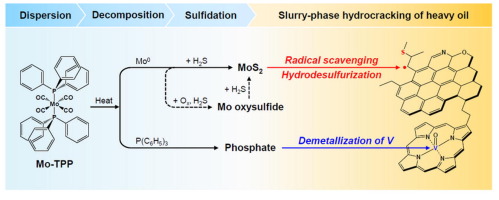Journal of Catalysis ( IF 6.5 ) Pub Date : 2020-03-06 , DOI: 10.1016/j.jcat.2020.02.007 Ki Hyuk Kang , Ngoc Thuy Nguyen , Pill Won Seo , Hwimin Seo , Gyoo Tae Kim , Narae Kang , Chul Wee Lee , Seung Ju Han , Min-Chul Chung , Sunyoung Park

|
A practical approach to enhancing the performance of dispersed catalysts during slurry-phase hydrocracking is the modification of the ligand structure of the catalyst precursor. An oil-soluble Mo precursor with triphenylphosphine ligands (Mo-TPP) was prepared and further applied to the slurry-phase hydrocracking of vacuum residue (VR). For comparison, a commercial precursor termed Mo-octoate was also used. In a dispersibility test, Mo-TPP was completely dissolved at 200 °C and then finely dispersed in the VR. Thermogravimetric analysis revealed that Mo-TPP decomposed rapidly in the range 220–270 °C to produce zerovalent Mo. During the decomposition process, direct conversion of Mo-TPP to MoS2 was favored via reaction with H2S gas generated from the VR at 250 °C. The sulfidation behavior of Mo-TPP reduced the average size and stacking number of the resulting unsupported MoS2 catalyst, which led to greater exposure of the rim sites (Morim) on the catalyst surface than when Mo-octoate was used. The Mo-TPP precursor resulted in better catalytic performance than the Mo-octoate precursor in a semibatch reactor at 410 °C and under 110 bar H2. In particular, the use of Mo-TPP enhanced the radical scavenging and hydrodesulfurization activities, owing to excellent hydrogenation ability originating from the initial number of Morim sites. The phosphate compound, derived from the TPP ligands, promoted the conversion of asphaltenes via demetallization of the intrinsic V species in the VR. These results demonstrated that Mo-TPP is an efficient precursor for achieving coke suppression that also improves product quality.
中文翻译:

Mo前驱体上重油的淤浆相加氢裂化:三苯基膦配体的影响
在淤浆相加氢裂化过程中提高分散的催化剂性能的一种实际方法是修饰催化剂前体的配体结构。制备了具有三苯基膦配体的油溶性Mo前驱体(Mo-TPP),并将其进一步应用于真空渣油(VR)的淤浆相加氢裂化。为了比较,还使用了商业上称为Mo-辛酸酯的前体。在分散性测试中,Mo-TPP在200°C时完全溶解,然后精细分散在VR中。热重分析表明,Mo-TPP在220-270°C范围内迅速分解,生成零价Mo。在分解过程中,通过与H 2反应,Mo-TPP直接转化为MoS 2是有利的。在250°C下VR产生的S气。Mo-TPP的硫化行为降低了所得无载体MoS 2催化剂的平均尺寸和堆积数,与使用Mo-辛酸酯相比,导致催化剂表面上的边缘位点(Mo rim)暴露量更大。在半间歇反应器中,在410°C和110 bar H 2下,Mo-TPP前体比Mo-辛酸酯前体具有更好的催化性能。特别地,由于源自Mo rim的初始数目的优异的氢化能力,Mo-TPP的使用增强了自由基清除和加氢脱硫活性。网站。源自TPP配体的磷酸盐化合物通过VR中固有V物种的脱金属作用促进了沥青质的转化。这些结果表明,Mo-TPP是实现焦炭抑制的有效前体,它还改善了产品质量。











































 京公网安备 11010802027423号
京公网安备 11010802027423号